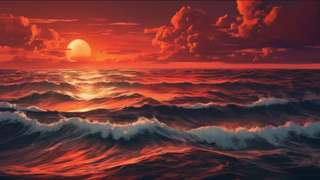Recent reports of the James Webb Space Telescope (JWST) detecting signs of life of a distant planet outside the solar system are, unfortunately, somewhat premature. That's the conclusion of research conducted by scientists from the University of California Riverside (UCR).
While likely to disappoint all of us eager for the confirmation of extraterrestrial life, however, it doesn't mean the JWST won't find traces of life in the atmosphere of an extrasolar planet, or "exoplanet," in the future.
The recent excitement around the potential detection of life signs on an exoplanet started in 2023 when the JWST detected potential "biosignature" elements in the atmosphere of the exoplanet K2-18 b, a super-Earth located around 120 light-years from Earth.
Though many exoplanets are extreme, violent or at least "alien" in nature — whether they're blasted by intense radiation from their stars, lack a solid surface or are frozen relics at the edge of their systems — K2-18 b was a tantalizing target in the search for life because it is rather similar to our planet.
Related: James Webb Space Telescope forecasts clouds of melted rock on this blisteringly hot exoplanet
An Earth-like ocean world
K2-18 b is between two and three times the width of Earth with 8.6 times the mass of our planet. It's also located in the habitable zone of its star, the region neither too hot nor too cold to support liquid water. The exoplanet is thus theorized to be an ocean, or "hycean" world, replete with liquid water — a vital ingredient for life as we know it. Unlike Earth, however, the atmosphere of this exoplanet seems to be mainly hydrogen rather than nitrogen.
"This planet gets almost the same amount of solar radiation as Earth. And if atmosphere is removed as a factor, K2-18 b has a temperature close to Earth's, which is also an ideal situation in which to find life," team member and UCR project scientist Shang-Min Tsai said in a statement.
The key takeaway from the 2023 investigation of K2-18 b, conducted by University of Cambridge scientists using the James Webb Space Telescope, was the discovery of carbon dioxide and methane. These molecules were detected without traces of ammonia, which indicated that this should indeed be a hycean world with a vast ocean under a hydrogen-rich atmosphere. But there was also the hint of something else — something very exciting.

"What was icing on the cake, in terms of the search for life, is that last year these researchers reported a tentative detection of dimethyl sulfide, or DMS, in the atmosphere of that planet, which is produced by ocean phytoplankton on Earth," Tsai said. That means if DMS is accumulating to detectable levels, there must be something on K2-18 b, possibly a lifeform, producing it at 20 times the rate found on Earth.
There's icing on the super-Earth cake, but can we eat it?
Because the detection of DMS was inconclusive, however, even the team leader of the investigation, University of Cambridge scientist Nikku Madhusudhan, urged caution with regard to the discovery of DMS. He said future JWST observations would be needed to confirm its presence in the atmosphere of K2-18 b — but not everyone got the memo.
However, that inconclusive nature of the DMS detection also prompted the UCR team to follow up on the detection.
"The DMS signal from the JWST was not very strong and only showed up in certain ways when analyzing the data," Tsai said. "We wanted to know if we could be sure of what seemed like a hint about DMS."
What this second team found with computer models accounting for hydrogen-based atmospheres and for the physics and chemistry of DMS was the original data was unlikely to point to the detection of DMS. "The signal strongly overlaps with methane, and we think that picking out DMS from methane is beyond this instrument's capability," Tsai said.
That means the JWST will need to look at the world with instruments other than the NIRISS (Near-Infrared Imager and Slitless Spectrograph) and NIRSpec (Near-Infrared Spectrograph) used to conduct the initial investigation that detected hints of DMS. Fortunately, Madhusudhan's team is continuing to observe K2–18 b with the JWST's other primary instrument, the MIRI (Mid-Infrared Instrument), as the researchers gather more intel about the environmental conditions on the exoplanet.
"The best biosignatures on an exoplanet may differ significantly from those we find most abundant on Earth today," team leader and UCR astrobiologist Eddie Schwieterman said. "On a planet with a hydrogen-rich atmosphere, we may be more likely to find DMS made by life instead of oxygen made by plants and bacteria as on Earth."
RELATED STORIES:
Is this slight disappointment a setback for scientists searching the cosmos for signs of life? Not a chance — nor does it overshadow the initial investigation's importance as a step forward in our understanding of hycean worlds, some of the most promising targets in that search.
"Why do we keep exploring the cosmos for signs of life?" Tsai asked rhetorically. "Imagine you’re camping in Joshua Tree at night, and you hear something. Your instinct is to shine a light to see what's out there. That's what we're doing too, in a way."
The new study discussing these findings was published on May 2 in The Astrophysical Journal Letters.
https://news.google.com/rss/articles/CBMiS2h0dHBzOi8vd3d3LnNwYWNlLmNvbS9qYW1lcy13ZWJiLXNwYWNlLXRlbGVzY29wZS1saWZlLWVhcnRoLWV4b3BsYW5ldC1zdHVkedIBAA?oc=5
2024-05-03 16:30:01Z
CBMiS2h0dHBzOi8vd3d3LnNwYWNlLmNvbS9qYW1lcy13ZWJiLXNwYWNlLXRlbGVzY29wZS1saWZlLWVhcnRoLWV4b3BsYW5ldC1zdHVkedIBAA
Bagikan Berita Ini















0 Response to "Did the James Webb Space Telescope really find life beyond Earth? Scientists aren't so sure - Space.com"
Post a Comment